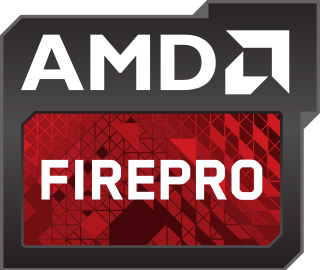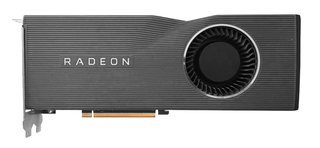
AMD FirePro was AMD's brand of graphics cards designed for use in workstations and servers running professional Computer-aided design (CAD), Computer-generated imagery (CGI), Digital content creation (DCC), and High-performance computing/GPGPU applications. The GPU chips on FirePro-branded graphics cards are identical to the ones used on Radeon-branded graphics cards. The end products differentiate substantially by the provided graphics device drivers and through the available professional support for the software. The product line is split into two categories: "W" workstation series focusing on workstation and primarily focusing on graphics and display, and "S" server series focused on virtualization and GPGPU/High-performance computing.

The Northern Islands series is a family of GPUs developed by Advanced Micro Devices (AMD) forming part of its Radeon-brand, based on the 40 nm process. Some models are based on TeraScale 2 (VLIW5), some on the new TeraScale 3 (VLIW4) introduced with them.

The Radeon HD 7000 series, codenamed "Southern Islands", is a family of GPUs developed by AMD, and manufactured on TSMC's 28 nm process.

The Radeon HD 8000 series is a family of computer GPUs developed by AMD. AMD was initially rumored to release the family in the second quarter of 2013, with the cards manufactured on a 28 nm process and making use of the improved Graphics Core Next architecture. However the 8000 series turned out to be an OEM rebadge of the 7000 series.

The Radeon 200 series is a series of graphics processors developed by AMD. These GPUs are manufactured on a 28 nm Gate-Last process through TSMC or Common Platform Alliance.

The Radeon 300 series is a series of graphics processors developed by AMD. All of the GPUs of the series are produced in 28 nm format and use the Graphics Core Next (GCN) micro-architecture.
The Radeon 400 series is a series of graphics processors developed by AMD. These cards were the first to feature the Polaris GPUs, using the new 14 nm FinFET manufacturing process, developed by Samsung Electronics and licensed to GlobalFoundries. The Polaris family initially included two new chips in the Graphics Core Next (GCN) family. Polaris implements the 4th generation of the Graphics Core Next instruction set, and shares commonalities with the previous GCN microarchitectures.

AMD Instinct is AMD's brand of data center GPUs. It replaced AMD's FirePro S brand in 2016. Compared to the Radeon brand of mainstream consumer/gamer products, the Instinct product line is intended to accelerate deep learning, artificial neural network, and high-performance computing/GPGPU applications.

The Radeon 500 series is a series of graphics processors developed by AMD. These cards are based on the fourth iteration of the Graphics Core Next architecture, featuring GPUs based on Polaris 30, Polaris 20, Polaris 11, and Polaris 12 chips. Thus the RX 500 series uses the same microarchitecture and instruction set as its predecessor, while making use of improvements in the manufacturing process to enable higher clock rates.
The Radeon RX Vega series is a series of graphics processors developed by AMD. These GPUs use the Graphics Core Next (GCN) 5th generation architecture, codenamed Vega, and are manufactured on 14 nm FinFET technology, developed by Samsung Electronics and licensed to GlobalFoundries. The series consists of desktop graphics cards and APUs aimed at desktops, mobile devices, and embedded applications.

The Radeon RX 5000 series is a series of graphics processors developed by AMD, based on their RDNA architecture. The series is targeting the mainstream mid to high-end segment and is the successor to the Radeon RX Vega series. The launch occurred on July 7, 2019. It is manufactured using TSMC's 7 nm FinFET semiconductor fabrication process.
The AMD Radeon 600 series is a series of graphics processors developed by AMD. Its cards are desktop and mobile rebrands of previous generation Polaris cards, available only for OEMs. The series is targeting the entry-level segment and launched on August 13, 2019.

RDNA 2 is a GPU microarchitecture designed by AMD, released with the Radeon RX 6000 series on November 18, 2020. Alongside powering the RX 6000 series, RDNA 2 is also featured in the SoCs designed by AMD for the PlayStation 5, Xbox Series X/S, and Steam Deck consoles.

The Radeon RX 6000 series is a series of graphics processing units developed by AMD, based on their RDNA 2 architecture. It was announced on October 28, 2020 and is the successor to the Radeon RX 5000 series. It consists of the entry-level RX 6400, mid-range RX 6500 XT, high-end RX 6600, RX 6600 XT, RX 6650 XT, RX 6700, RX 6700 XT, upper high-end RX 6750 XT, RX 6800, RX 6800 XT, and enthusiast RX 6900 XT and RX 6950 XT for desktop computers; and the RX 6600M, RX 6700M, and RX 6800M for laptops. A sub-series for mobile, Radeon RX 6000S, was announced in CES 2022, targeting thin and light laptop designs.

RDNA 3 is a GPU microarchitecture designed by AMD, released with the Radeon RX 7000 series on December 13, 2022. Alongside powering the RX 7000 series, RDNA 3 is also featured in the SoCs designed by AMD for the Asus ROG Ally and Lenovo Legion Go consoles.

CDNA is a compute-centered graphics processing unit (GPU) microarchitecture designed by AMD for datacenters. Mostly used in the AMD Instinct line of data center graphics cards, CDNA is a successor to the Graphics Core Next (GCN) microarchitecture; the other successor being RDNA, a consumer graphics focused microarchitecture.

The Radeon RX 7000 series is a series of graphics processing units developed by AMD, based on their RDNA 3 architecture. It was announced on November 3, 2022 and is the successor to the Radeon RX 6000 series. Currently AMD has announced and released seven graphics cards of the Radeon RX 7000 series: RX 7600, RX 7600 XT, RX 7700 XT, RX 7800 XT, RX 7900 GRE, RX 7900 XT, and RX 7900 XTX. AMD officially launched the RX 7900 XT and RX 7900 XTX on December 13, 2022. AMD released the RX 7600 on May 25, 2023. AMD released their last two models of the RDNA 3 family on September 6, 2023; the 7700 XT and the 7800 XT. As of January 2024, AMD have also released the RX 7600 XT and the RX 7900 GRE.












